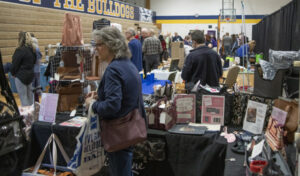
(Publisher’s note: Part one of this column ran yesterday.)
By Jennifer Fairfield, owner the Garden Mill
Trees and Shrubs:
The only pruning of trees and shrubs that should be done between now about February is to remove dead or damaged branches. Generally, the best time to prune most trees and shrubs is in February, when they are dormant. There are some exceptions to that rule, mostly for early-spring blooming plants, but there really isn’t anything that should be pruned now.
While the ground is still soft, put up stakes to use to attach burlap to for wind barriers around evergreen trees and shrubs. You can wait a little bit to put the burlap up, but having the stakes in place now means you aren’t trying to pound them into the frozen ground. Placing burlap windscreens around your evergreens is much better for them than wrapping them in burlap or other protective cloth. Anything you wrap around them can get weighed down by ice and snow, potentially leading to breaking of limbs under the weight.
Keep hoses handy while the temperatures are still above freezing, so that you can water your trees and shrubs if we aren’t getting at least an inch of rain each week. Evergreens, especially, need to be really well hydrated before winter sets in, because they more easily lose moisture through their needles throughout the winter than trees and shrubs that shed their leaves. Just be sure to fully empty hoses after each use at this time of year so that you don’t risk having the water in them freeze and expand, causing the hose to crack, when temps fall below freezing at night.
As with your flower beds, add a layer of fresh mulch to trees and shrubs, to help them get through the winter. A two- or three-inch layer of mulch is good, but don’t pile it up against the trunk. Mulch right up against the trunk can cause moisture to build up on the bark, leading to decay of the bark, which then leads to disease and pests that can cause serious damage.
Lawn and Leaves:
What to do about leaves? For many reasons, leaving lots of whole leaves on your lawn isn’t good for it – they can smother the lawn, reducing growth in the spring, and they can promote snow mold, a fungal disease that can leave large, ugly patches of dead grass.
There are also lots of really good reasons to leave the leaves alone – they can provide nutrients back to your soil (and therefore your grass), and they can provide overwintering habitat for lots of beneficial insects. Besides, all that raking can be bad for your back, and leaf blowers are really bad for the environment. So, if you have a lot of leaves, consider mowing them up and leaving the bits on your grass for the nutrients they can provide. But if you don’t have a thick layer of leaves, consider leaving them where they are, or raking them into your flower beds to provide mulch for your flowers and habitat for the insects – a win-win.
Tools:
When you’re all done with your garden clean-up, be sure to tend to your tools. Clean, dry, sharpen, and lubricate your garden tools before you put them away so they’ll be ready to get right to work in the spring. Sharpen your shovels, too. A sharp shovel makes digging so much easier.
A great way to store your shovels over the winter is to give them a good coating of oil and then stick them into a bucket of sand mixed with oil. The oil helps to keep moisture away, and the sand helps to keep the shovels sharp.
Once the ground is frozen, empty hoses, roll them up, connect the ends of each hose to keep spiders from using them as nesting places, and tie them to keep them from tangling over the winter. I also like to put my sprinkler heads and wands all in one place, so I don’t have to remember what I did with them next year. A trug (my favorite garden tool) or bucket works well for this. If you have rain barrels, empty them and put them away, too.

Birds:
If you don’t feed your birds year-round, from now to next spring is the best time to do so. During the warmer months, the biggest source of food for most birds is insects. As it gets cold, and insects aren’t available, birds turn to vegetation for their food.
But they need to eat a lot more vegetation to get the same amount of protein they get from insects, and they need at least as much protein to help them get through the cold days and nights. This is where you come in. When you provide food for the birds, you help them keep from using up precious energy, that they need to stay warm, trying to find food.
Just remember to clean the feeders at least weekly to help prevent the spread of disease.













